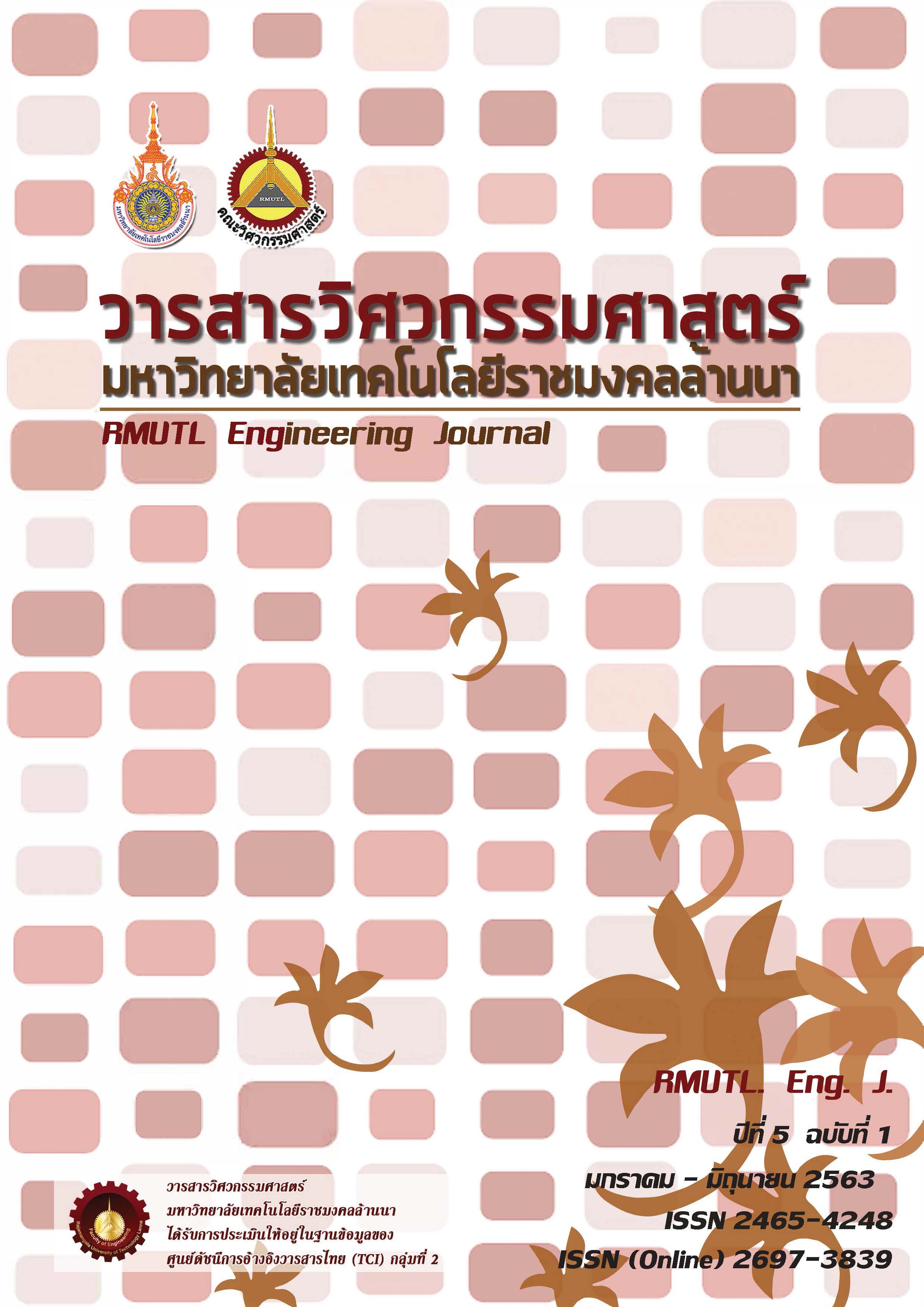Compressive Strength of Coal and Biomass Ashes Mixed with Laterite-Cement in Interlocking Compressed Bricks
DOI:
https://doi.org/10.14456/rmutlengj.2020.3Keywords:
Interlocking brick, Coal, Biomass, Ash, Compressive StrengthAbstract
The objective of this research is to use waste coal and biomass ash from power plants to develop laterite-cement interlocking compressed bricks. The coal and bio mass ashes were collected from Mae-Moh coal fired power plant in Lampang and fuel power plant in Lampun. Portland cement was partially replaced with ash at ratios cement:ash 0.7:0.3 0.6:0.4 0.5:0.5 0.4:0.6 and 0.3:0.7 and curing time of 3 7 14 and 28 days. Compressive strength, total unit weight and percentage of water absorption were investigated. Testing results showed that the unit weight of each series of interlocking bricks decreased with the increase of the cement replacement percentage of fly ash. Compressive strength of fly ash interlocking brick at 0.7:0.3 reached the Industrial standard for bearing load concrete block TIS 57-2533 and that all the mixtures reached the Industrial standard for no bearing load concrete block TIS 58-2533. The study showed that the compressive strength and low unit weight of interlocking bricks was adequate with partial replacement of Portland cement with ashes. The use of Ash to reduce dead weight of structures is more environmentally friendly and also saves costs. when compared with using Portland cement. It’s use is also beneficial for the construction industry because it encourages them to use industrial by-products and so increase their environmental credibility.
References
2.Kamhang W, Janbanjong B. Thailand institute of scientific and technological research (online). Available: fromhttp://technologyblockprasan.com/information1_2.php/ [Accessed: 30 June 2018].
3.Dasaesamoh A, Maha H, Chebueraheng H. Properties of interlocking block from para rubber wood fly ash mixed Narathiwat kaolin. J. Res. Unit Sci. Tech. Environ. Learning. 2014; 5(2):202-208.Thai.
4.Saramakon S. Usage of fly ash for manufacturing interlocking block. Master Thesis. Suranaree University of Technology, Nakhonratchasima; 2013.Thai.
5.Rukzon S, Phupa W, Ngenprom N, Chindaprasirt P. Final Report. The innovation of use bottom ash on green concrete. Rajamangala University of Technology Phra Nakhon. Bangkok; 2012. Thai.
6.Sujjavanich S, Suwanwitaya P. Final Report. Durability of fly ash concrete. Electricity generating authority of Thailand. April. 2003. Thai.
7.Dumrongsil S, Sujjavanich S. Effect of Cement containing binary blended bagasse ash-fly ash on physical and mechanical properties of concrete. KMUTT Research and Development Journal. 2007;30(3):489-499.Thai.
8.Dumrongsil S, Sujjavanich S. Effect of Cement containing binary blended bagasse ash-fly ash on physical and mechanical properties of concrete. KMUTT Research and Development Journal. 2007;30(3):489-499.Thai.
9.Dechburum A, Chaimoon K. Properties of interlocking block containing fly ash and bottom ash. SWU Engineering Journal. 2019;14(1):99-105.Thai.
10.Klabprasit T, Jaturapitakkul C, Chindaprasirt P, Songpiriyakij S. Fly ash and biomass ash Based geopolymer pastes Part I: Effect of mix proportion on compressive strength. Research
and Development Journal. 2008;19(2):11-16. Thai.
11.Ramjan S, Tangchirapat W, Jaturapitakkul C. Effect of finesses of fly ash and rice husk ash on compressive strength and expansion of mortar in accelerated mortar bar method. Journal of Thailand Concrete Association. 2017;5(1):1-13.Thai.
12.TIS. 1990. Standard for hollow-bearing concrete masonry unit. TIS 57-2533. Thai Industrial Standards Institute.
13.TIS. 1990. Standard for hollow non-load-bearing concrete masonry unit. TIS 58-2533. Thai Industrial Standards Institute.










